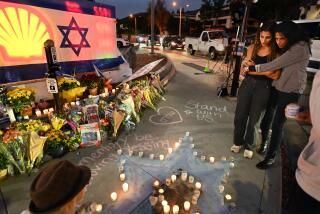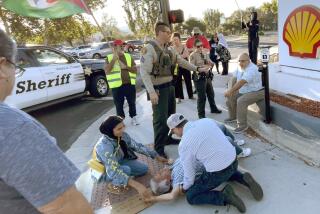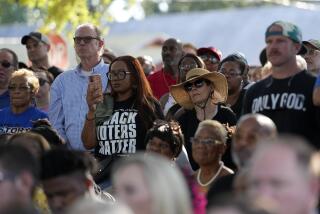Thousands march through Staten Island to protest Eric Garner’s death
- Share via
Reporting from New York — Thousands of people marched peacefully through Staten Island on Saturday, chanting “No justice, no peace” and “I can’t breathe” as they protested the death of Eric Garner, who died after a New York police officer subdued him with a chokehold.
The march — organized by the Rev. Al Sharpton’s National Action Network — began at noon, starting at the place where Garner died and ending at the Staten Island district attorney’s office.
As demonstrators walked, they sporadically invoked the death of 18-year-old Michael Brown and subsequent protests in Ferguson, Mo., raising their hands in the air and saying, “Hands up, don’t shoot.” Brown, like Garner, was black. The officer who shot him was white.
Garner, 43, died on July 17 after a police officer arrested him on suspicion of selling untaxed cigarettes. A video recorded on a cellphone shows Garner — a 350-pound father of six — saying that he couldn’t breathe as a police officer restrains him in a chokehold. Earlier this month, the medical examiner’s office ruled the death a homicide.
“Enough is enough,” Rashida Johnson, a 32-year-old from the Bronx, said as she marched Saturday.
The next victim, Johnson said, could be someone from her family.
“It’s always young men and women of color,” another woman interjected as she walked by holding a “We will not go back” sign.
“It’s ridiculous,” Johnson responded. “And when will it end?”
Some Staten Island residents had feared Saturday’s protest could turn ugly, especially after events in Ferguson. “Although the march is considered peaceful, there is no guarantee that everyone in attendance will act sensibly,” said a letter issued to local businesses by the Staten Island Chamber of Commerce. “It is important that personal safety and general precautions be utilized.”
But peace prevailed. After the march, Sharpton, Garner’s family, the mothers of Amadou Diallo, Ramarley Graham and Sean Bell — black men also killed by NYPD officers — praised the crowd for conducting a pointed, though non-violent, demonstration.
“What do we want?” Sharpton asked the demonstrators.
“Justice,” they shouted.
“When do we want it?” he asked.
“Now!”
“We are not here to cause violence,” Sharpton said. “We’re here because violence was caused.”
The march also drew former New York Gov. David Paterson, who spoke before the march stepped off. He listed the names of people killed in altercations with police in New York City — from 10-year-old Clifford Glover, who was shot in the back by an NYPD officer in 1973, to Garner.
“We will march for all of them,” Paterson said.
Many marchers carried signs: “Justice for Eric Garner” and “Respect Human Rights.” Two men wore surgical masks on which they had written “I can’t breathe.” One man wore a white T-shirt with “Don’t shoot, I’m not armed!!” scrawled in black marker on the back.
Rep. Jose E. Serrano, a Democratic congressman from the Bronx, said, “We need police protection. We don’t need police aggression.”
The country, he said, is watching New York closely right now.
Esaw Garner, Garner’s widow, thanked the crowd for their support and his eldest daughter, Erica, said her father is “very proud right now.”
“People are standing up and speaking for him,” she said.
Sharpton and Garner’s family met Thursday with the local U.S. attorney to discuss potential federal intervention in further investigations of Garner’s death.
Daniel Pantaleo, the officer who restrained Garner in the chokehold, has been stripped of his gun and placed on desk duty. Another officer, Justin D’Amico, has also been also placed on desk duty.
A grand jury will hear evidence concerning his death next month.
Constance Malcolm, the mother of 18-year-old Ramarley Graham, who was killed by NYPD Officer Richard Haste more than two years ago, said that the Staten Island district attorney shouldn’t handle Garner’s case. Haste was indicted for manslaughter in 2012, but the indictment was tossed out due to a prosecutorial mistake. A second grand jury declined to indict Haste and the Department of Justice said it would review the case.
That was more than a year ago.
More to Read
Sign up for Essential California
The most important California stories and recommendations in your inbox every morning.
You may occasionally receive promotional content from the Los Angeles Times.










